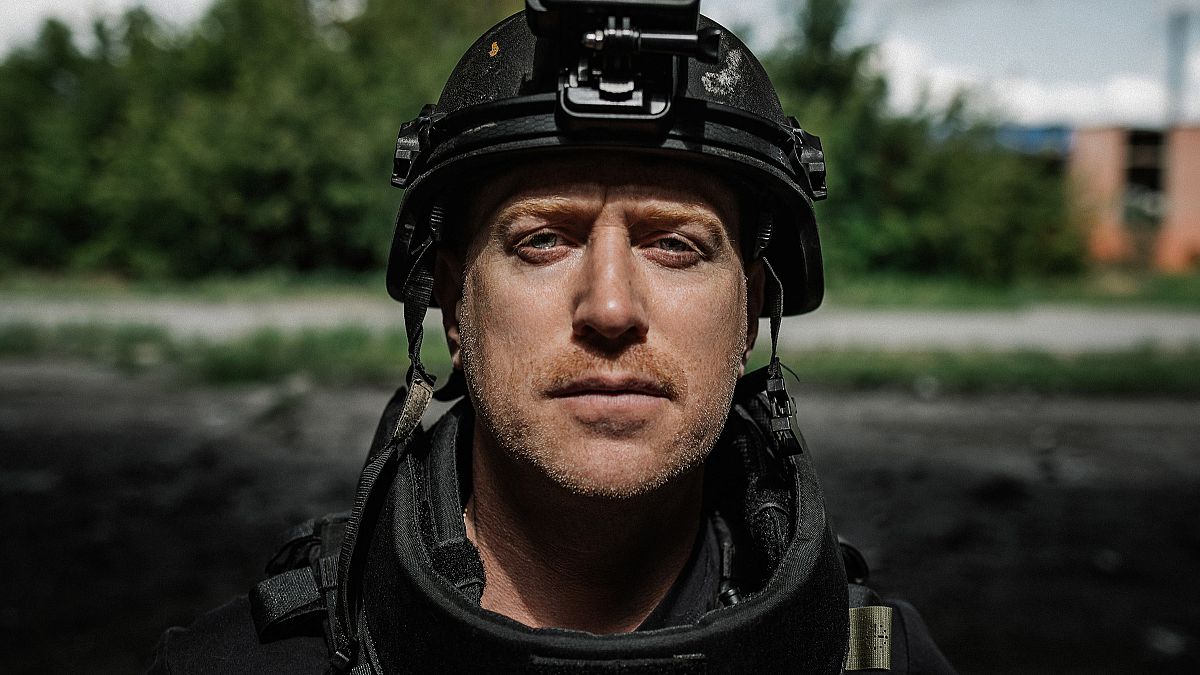A TV host, a YouTube blogger and a showman. Denys Khrystov had a very different life before Russia’s invasion. Now a volunteer evacuating civilians from the most dangerous places on the frontline, Denys says he doesn’t know how many he rescued, but he remembers everyone he did not evacuate.
With almost 200,000 followers on Instagram, one has to scroll down through hundreds of videos and photos of destroyed Ukrainian cities to see what Denys Khrystov’s life was like before Russia’s full-scale invasion.
A showman and a TV and YouTube host, Khrystov used to entertain people. He now saves them from the most dangerous places on the frontlines.
Euronews met Khrystov in Brussels to talk about his work amid Moscow’s ongoing war and what he calls the new wartime “travel show”.
Khrystov signed up to volunteer from the very early days of the full-scale invasion in February 2022. He says he doesn’t know how many people he rescued; instead, he calculated the distance he covered across Ukraine in almost three years — adding up to over 1 million kilometres.
When asked if he remembers how many people he didn’t evacuate, Khrystov says he remembers each and every one. “Their faces and the information about them are stored both in my phone and graved in my memory,” he pondered.
The places he travels to are so close to the frontlines that often, there is no mobile phone coverage or internet connection. Khrystov is regularly contacted by family members, who find his phone number and call, begging to evacuate their loved ones from the town and villages where hardly anything is left.
He has had to return a few times when those few people who stayed after the organised mass evacuations still refuse to leave what’s left of their houses and homes.
Usually, these people don’t leave the basement, which serves as a bomb shelter from constant shelling, and they are not even aware of the scorched earth around them, Khrystov says.
Why do they stay, and why don’t they leave when it is still relatively safe?
The story of a ‘stubborn grandpa’
These people, Khrystov says, have no connection to the outside world and their families, and they don’t even comprehend the scale of danger and destruction.
When Denys and volunteers like him come to help while risking their own lives, people actually often say no. This means volunteers must repeatedly return, trying to persuade people to evacuate. When the Russian forces close in, there might be days, if not hours, left to escape.
“I went twice to evacuate an old man, he said no both times. I called him ‘my stubborn grandpa’. When I came for the third time he finally agreed to evacuate,” Khrystov recalls.
“That was late. He should have evacuated earlier, but at least he managed to evacuate somehow on time.”
The settlement of Kyslivka, in Kharkiv region’s Kupyansk district, where Khrystov went three times, has since been destroyed and fully occupied by Russian troops.
Why do people refuse to evacuate? Khrystov says the old man explained it to him: “I asked him why he didn’t agree to leave the first two times. And he said he didn’t want to be a burden for his children. That’s it.”
Khrystov says that people usually notice the war when it’s too late, and at first, they simply don’t believe it is real, “don’t believe it is possible to die on the way to the local shop.”
In the first days and weeks of Russia’s full-scale invasion in 2022, Khrystov saw lots of Russian claims that the footage of the missile attacks and the shelling against civilians was not real.
“They wrote that this is all fake, that it had been staged. This is when I decided to film and document everything I see,” Khrystov explains.
This is why he believes it is crucial to produce documentaries about the war as soon as possible.
“They are going to give lots of answers and will put in question lots of content of the Russian propaganda machine,” Khrystov explains, even if his team is “trying to put themselves together to get to editing and producing it, because it is very hard emotionally even to work on it.”
‘One Percent of War’
Khrystov doesn’t have a crew; everything is filmed on his phone, and a GoPro camera is on his tactical helmet. There is no filtering or censorship either. He says the idea is to show the raw reality of civilian evacuation at war.
Hundreds of hours of footage are now being turned into a documentary, “One Percent of War”.
The film tells a story of evacuations from Avdiivka, the town in the Donetsk region, which Russia occupied in mid-February of this year.
One Percent of War shows stories of the evacuation of a severely wounded Ukrainian soldier, a villager who was the only one left in the street, the body of a deceased Ukrainian civilian and her caretaker and even animals.
Khrystov says when some of these people finally agreed to evacuate, there was only one road and few days or even hours left to make it through.
On camera, one of the evacuated civilians rescued by Khrystov from Avdiivka told him he wanted to go to Pokrovsk to see his family.
Half a year since that story was filmed, Pokrovsk is now the most dangerous part of the frontlines as Russian forces are closing in on the settlement after months of constant shelling.
Out of a population of 60,000 before the war, most of the civilians have evacuated from here. However, Ukrainian officials say that about 11,000 people still remain in Pokrovsk, which, just like Avdiivka, is being turned into scorched earth. In contrast, many civilians probably realise there is almost no time or roads left to evacuate.
This means Khrystov and volunteers like him are risking their lives yet again for the last chance to evacuate the remaining civilians.
Read the full article here


